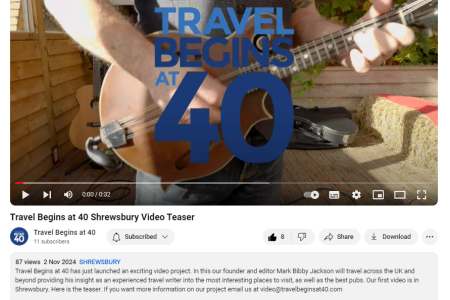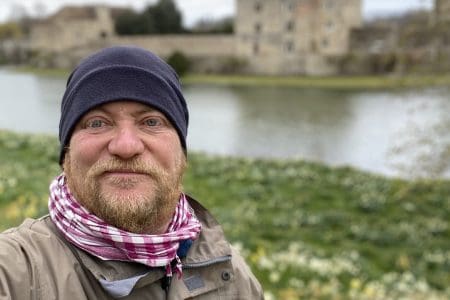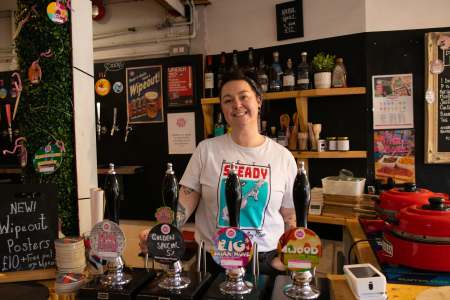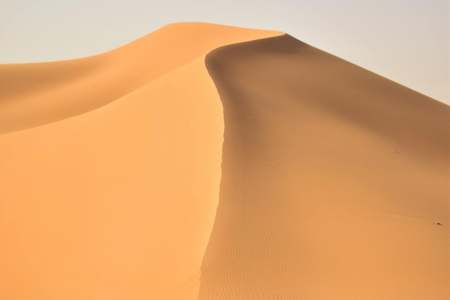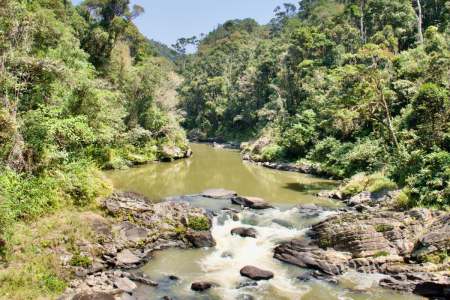Cambodia is rightly an emerging tourist destination. With the spectacular temple complex at Angkor as its main drawcard, the country is a must for the cultural traveller. But apart from majestic Angkor Wat, there is so much to enjoy in the southeast Asian country.
Temple complexes are dotted around the country, often discovered by the occasional tourist. From Preah Vihear in the north to the other Ta Prohm (not the one of Tomb Raider fame), let us guide you through some of the best temples in Cambodia.
The capital Phnom Penh with its wonderful riverfront, contains a secretive buzzing restaurant and bar scene – not to mention affordable boutique hotels. Siem Reap is so much more than a base camp to assault Angkor. There is much to entertain in the kingdom’s towns and cities, most of it hidden from the day-tripper.
Cambodia still retains some of the region’s last vestiges of untouched nature in parts of the Cardamom Mountains
Kep and Kampot have recently found their way on the tourist trail, but what about the country’s second city Battambang with its bamboo trains and artistic heritage, or Kampong Cham and even Kratie with its endangered dolphins. There is so much more to unearth on your Cambodia holidays.
Outside of the cities, Cambodia still retains some of the region’s last vestiges of untouched nature in parts of the Cardamom Mountains, with up-market eco-glamping allowing you to discover the undiscovered in luxury. And off the southern coast near Sihanoukville are islands and beaches that would make di Caprio think the Beach not worth a second look.
A vibrant contemporary art scene, incredibly friendly people and surprising gastronomy add to make the former Khmer kingdom a quite glorious place to visit. Follow us on our guide to Cambodia travel for an experience that will live with you for ever.
Read on for more guidance on Cambodia travel for the Over 40s.
Cambodia Religion, Heritage and Culture
Cambodia is steeped in history, with nods to its rich culture and customs on show in every corner. Buddhism is the national religion, with 97 percent of the population following Theravada Buddhism. Pagodas pepper the country; lines of saffron robe-clad monks collect alms each morning; statues and images of Buddha dot homes, businesses and public spaces; and temples are regularly attended by the majority of the population.
This means Cambodians are conservative, gentle and respectful by nature. And it pays well to bare this in mind during your time in the Kingdom. Modest dress when attending temples, religious sites and important attractions is necessary. Knees and shoulders should be covered at all times, and shoes, hats and sunglasses removed when entering a temple.
Angkor Wat doesn’t just serve as Cambodia’s main tourist pull, it also forms the centre of national pride
At many sites, visitors turning up sporting hot-pants, sleeveless tops and other attire deemed inappropriate will be refused entry or required to hire a hideous cover-up. And definitely don’t follow in the idiotic footsteps of a flurry of fools who were kicked out of the country after snapping nude selfies of themselves at Angkor Wat in 2015.
Angkor Wat doesn’t just serve as Cambodia’s main tourist pull, it also forms the centre of national pride.
It comes as no surprise that contemporary culture is saturated in Angkor influence. The apsara dancers etched onto the walls at Angkor are brought to life in a range of classical dance performances in Siem Reap and Phnom Penh. And the ethereal females said to visit Earth from Heaven to entertain gods and kings with their enchanting dance feature heavily in the contemporary Cambodian dance forms and modern art that has emerged in recent years.
Other forms of traditional Khmer arts include shadow puppetry. The pre-Angkorian artform – bas-relief carvings at 7th century Sambor Prie Kuk temple in Kampong Thom show the ceremony – is believed to have been born in Siem Reap, where performances took place in paddy fields or pagodas to mark special occasions.
Cambodia Living Arts (CLA) works tirelessly to revive traditional arts, while encouraging a new wave of musicians to carve their own contemporary path
Sbek thom was added to Unesco’s Representative List of the Intangible Cultural Heritage of Humanity in 2008 and is the most popular form of shadow puppet theatre. It features two-metre tall puppets made from cowhide and retells parts of the epic Reamker – the Khmer version of the Ramayana, an ancient Indian epic poem. Watch shadow puppet shows, and other traditional art performances, at Sovannaphum Arts Association in Phnom Penh or Bambu Stage in Siem Reap.
NGO Cambodia Living Arts (CLA) works tirelessly to revive traditional arts, while encouraging a new wave of musicians to carve their own contemporary path. Daily, its talented troupes put on performances at its stage at the National Museum, Phnom Penh. These take in traditional music, apsara, folk dance and the ritual dance, Moni Mekala. Every Wednesday, Friday and Sunday catch the upbeat drums of all-female group Medha and their show, The Call, at CLA’s new stage at Bambu Stage, Siem Reap.
For a contemporary spin on classical dance, drop into Java Creative Café’s Counterspace Theatre, every Thursday and Friday at 6.30pm for Sophiline Arts Ensemble’s award-winning shows that fuse classical Cambodian dance with contemporary moves. Every Saturday and Sunday, the venue hosts Cambodia’s first all-gay dance troupe to draw influence from apsara, Prumsodun Ok & NATYARASA.
Another great spot to delve into Cambodia’s rich heritage is at Artisans Angkor. In Siem Reap, visitors can take a free tour of its workshops where artisans are hand-carving a range of traditional Khmer crafts. These range from lacquer painting and stone and wood carving, through to silverware and silk weaving.
Two free buses also depart daily for its silk farm, about a 20-minute drive into the countryside. Here, visitors can see the process first-hand, from plumping up the silk worm on mulberry leaves and dyeing the thread, to the finished product.
Cambodia Flag
Cambodians are extremely proud of their Angkorian heritage. Evidence of the Angkor Empire’s importance can be seen on the national flag, which features the iconic 12th century temple, Angkor Wat. Did you know that Cambodia and Afghanistan are the only countries whose flag features a structure? The Afghanistan flag has a national emblem at its centre rather than a specific building.
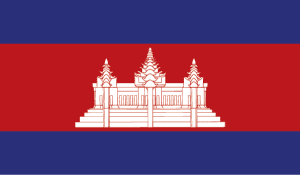
Latest Cambodia Travel Industry News
Cambodia Wildlife, Outdoors and Nature
Cambodia is the perfect spot for nature enthusiasts and avid adventurers who like to hop off the beaten track. Away from the major urban hubs, the country is mostly sweeping countryside, jungle-clad mountains and dense tropical forest. It’s awash with authentic adventures and opportunities to dive into the heart of the wild.
While the country’s collection of endangered flora and fauna is shrinking, thanks to decades of illegal logging and poaching, Cambodia is still home to an abundance of rare and exotic birds, mammals and marine life. The considerable range of conservation efforts taking place is giving many species a new lease of life, while a rising number of eco-tourism projects means guests can experience Cambodia’s wealth of wildlife first-hand.
Phnom Tamao Rescue Centre is operated by wildlife rescue NGO Wildlife Alliance and is a great day trip from the capital, sitting about 30km away. The organisation works to stamp out Cambodia’s illegal animal trade and wildlife trafficking, and the rescue centre plays an integral role in its mission. Rescued and seized animals are taken to the centre, where they are rehabilitated before being released back into the wild.
It cares for a range of species, such as tigers, deer, leopard cats, elephants and gibbons. Wildlife Alliance runs a day tour, which includes feeding elephants, entering the tiger’s den, spending time with hand-reared baby animals and hanging out with macaques in their enclosure.
Elephant Valley Project offers respite to overworked and abused elephants at its sprawling sanctuary in the heart of the area’s rugged jungle
Another pioneering project from Wildlife Alliance that will tickle the fancy of nature lovers is its wildlife release station in the heart of Koh Kong. Here, sun bears, monkeys, birds and cloud leopards are all a step away from being sent home as they await their release back into the wild. Rangers are on hand to explain each of the animal’s story, with treks through the jungle available. Basic huts provide accommodation.
Birders will be in their element at Sam Veasna Centre. The Siem Reap-based organisation has been running tours to fund its work to protect and preserve the country’s birdlife since 2006. Half-day through to multiple day trips, led by English-speaking guides, showcase Cambodia’s range of birds, from Bengal floricans and giant and white-shouldered ibis, to critically-endangered species of vulture.
For some elephant action on your Cambodia travel, head to Mondulkiri. Elephant Valley Project offers respite to overworked and abused elephants at its sprawling sanctuary in the heart of the area’s rugged jungle. Visitors can sign up to a range of trips, from a full-day through to five days. These take in treks to watch elephants bathing in rivers or stomping through the trees and learning about the indigenous Bunong tribes that call Mondulkiri home.
The central province of Kratie is home to a small collection of endangered Irrawaddy dolphins
The central province of Kratie is home to a small collection of endangered Irrawaddy dolphins. Inhabiting a 118-mile stretch of the Mekong River between Cambodia and Laos, the dolphins are close to extinction, with an estimated 78 to 91 remaining – and some of them like to hang out in a spot of water just a short boat ride from Kratie.
It’s easy to organise a trip yourself – get a tuk tuk to the boat docks at Kampi, about 11km from the town of Kratie, and haggle the price of a boat to about US$10 – but a wonderful way to get a snapshot into authentic rural local life is to sign up to one of CRDT’s (Cambodia Rural Discovery Tours) offerings.
It works with underprivileged communities across the province to offer a range of homestays, eco-adventures and local experiences that steer well and truly away from Cambodia’s tourist hotspots. These include trips to see the dolphins and a breeding programme that is bringing the giant Cantor’s softshell turtle back from the brink of extinction.
If you prefer to inject a bit of glamour into your wilderness experience, then check-in to Cardamom Tented Camp. The luxury glamping resort in the heart of the Cardamom jungle sees a handful of safari tents, complete with a king size bed, Western-style toilet, and steaming hot power shower, dotted in a natural plain. All profits are ploughed into funding rangers who protect the jungle from loggers and poachers. Guests can accompany them on their patrols, kayak, trek, or relax on the sundeck.
For a taste of the absolute high-life, Shinta Mani Wild – The Bensley Collection opened in December, with 15 exclusive tents scattered along a 1.5km stretch of river and waterfalls. Located in an unprotected wildlife corridor connecting Bokor and Kirirom national parks, the resort offers curated adventures into the surrounding jungle.
Our Cambodia Travel Top 5 Temples
Angkor Wat
Bayon
Preah Vihear
Koh Ker
Ta Prohm at Tonle Bati
(read on for more details)
Cambodia Food
Cambodians love to graze, which means snacks are readily at hand. Street food is common across the country, with vendors pushing carts selling everything from sun-baked clams and num kachay (chive cakes), to chet chien (deep-fried bananas) and num banh chok (Khmer noodles).
The aroma of local herbs and spices float from local markets, and street-side stalls are set up on pavements at breakfast, lunch and dinner time, when Cambodians gather to eat at mobile metal tables and miniature plastic chairs.
Key ingredients include galangal, garlic, lemongrass, kaffir lime leaves and turmeric
Cambodian food may not sit up there globally with cuisine from neighbouring Thailand and Vietnam, but it’s slowly earning its place. Unlike its neighbours, where dishes tend to pack a real punch, Cambodian food is subtler with its spices.
Key ingredients include galangal, garlic, lemongrass, kaffir lime leaves and turmeric. These are commonly ground into a paste, called kroeung, and used as a base for cooking. Spice is usually added with dipping sauces featuring chopped chilli and garlic with fish or soy sauce, or black pepper (preferably Kampot pepper) with squeezed fresh lime.
Prahok also features heavily in Cambodian dishes. The crushed, salted and fermented fish paste is mainly used to season dishes but can also be eaten as a main course – be warned, this is not to be taken lightly. Having earned itself the nickname of Cambodia cheese, prahok is famous for its distinct taste and pungent smell.
Rice forms a staple in local diets. Cambodia is primarily a patchwork quilt of paddies and even the Khmer phrase for eating – “nyam bai” – literally translates as “eat rice”. Rice in some form features in every meal, from the popular breakfast dish of bobor (rice porridge) and kuy teav (rice-noodle soup), to nom banh chok, made from thin rice noodles.
Recent years have seen Cambodian cuisine given a refreshing contemporary twist
A contemporary form of Cambodian cuisine is also starting to rise from kitchens in restaurants in the urban hubs of Phnom Penh, Siem Reap, Battambang, Kampot and Kep. Between 1975 and 1979, an estimated quarter of the population perished under the Khmer Rouge. Passed down orally through generations, many Khmer traditions, including recipes, were almost lost.
Recent years have seen Cambodian cuisine given a refreshing contemporary twist. The revival has been led by Cambodian master chef Luu Meng, and his creative interpretations can be tasted at Malis restaurants in Phnom Penh and Siem Reap. Romdeng is a social enterprise led by NGO Friends International and puts a modern spin on classical Cambodian dishes – give the deep-fried tarantulas served with pepper and lime sauce a try, if you dare. Award-winning Cuisine Wat Damnak in Siem Reap fuses the finest flavours of France with Cambodia. While The Fishmarket Kampot serves up plates that are as easy on the eye as they are on the stomach, coupled with idyllic views of Kampot River.
Again, Cambodia’s cuisine can be explored through several tasty tours. Siem Reap Food Tours and its sister venture Phnom Penh Food Tours introduce guests to market life, back street cooking and a wide variety of street food. Kek Soon takes guests to her favourite local food spots in her hometown of Kampot with her culinary and culture tours. And Frizz restaurant’s cooking classes teach guests how to cook classic dishes, such as spring rolls, fish amok and mango and sticky rice.
Phnom Penh: Cambodia’s Capital
The Cambodian capital is a city undergoing rapid change. The sound of construction clatters through the air almost 24/7 as swathes of old Phnom Penh are razed to pave the way for a new chapter of modern shopping malls, high-rise condos, hotels and office blocks.
Sitting as Cambodia’s economic hub, Phnom Penh is traditionally seen as the gateway to Cambodia travel, with most visitors landing at the international airport and spending a couple of days exploring guidebook highlights before heading to Siem Reap or the coast. However, Phnom Penh is a city worth spending a bit of time in to scratch beneath the surface.
The mounting collection of intimate independent galleries that dot the capital offer a window into contemporary Cambodia
Away from the main tourist attractions of Tuol Sleng Genocide Museum (S-21), The Killing Fields (Choeung Ek Genocidal Centre), the National Museum and Royal Palace, there’s plenty more reasons to extend a stay.
The mounting collection of intimate independent galleries that dot the capital offer a window into contemporary Cambodia. Java Creative Café in Toul Tom Poung and Sa Sa Bassac showcase work from local contemporary artists. DinArt gallery features Teang Borin’s stunning mystical interpretations of apsara dancers, while Neverland Artspace – also home to n o w h e r e art studio – houses exhibitions from across the region.
Phnom Penh is a foodies’ delight, with street food readily available thanks to the stacks of mobile street carts and streetside vendors dishing out local delicacies. If fear over a sensitive stomach strikes, notable restaurants serving Cambodian cuisine include upmarket Malis. Sovanna 1 and Sovanna 2 pill out with locals and is famous for its barbecue, and Eleven One Kitchen serves affordable tourist-friendly local dishes.
Markets sit at the heart of local life, and there are plenty of options
Nightlife is ripe in Phnom Penh, and today it’s all about the vast network of hidden backstreets, alleys and lanes. Bassac Lane, tucked away off Street 308, is home to a quirky collection of themed bars and restaurants. TTP Lane, off Street 155, houses a smattering of intimate drinking spots, diners and boutiques. Dainty cafés, urban bars and snug eateries dot Street 240 ½, and cute diners, fashion stores and hidden speakeasy BattBong (look for the coke machine) can be found on the lane off Street 51, opposite Street 288.
For those tight on time, innovative tours are cropping up. ZIN Adventures – a social enterprise co-founded by five Cambodian-American deportees and two local advisors – run a 90-minute walking tour that introduces visitors to some of the secret stories buried in the Old European Quarter. The city’s shrinking architectural history is explored with Khmer Architecture Tours, led by local architects, artists and architect students. Sample the delights of street food with Phnom Penh Food Tours, or jump on the back of a motorbike with MotogirlTour, founded by a trio of young female Cambodians.
Markets sit at the heart of local life, and there are plenty of options. Phsar Thmei (Central Market) and Phsar Toul Tom Poung (Russian Market) are geared towards the tourist crowds and have undergone a makeover in recent years, tarting them up and making them easier to navigate. Barter for prices at the stalls spilling over with clothes, paintings, electrical goods household items, souvenirs and everything in between. For a more local experience, brave chaotic Orussey Market, Phsar Chas (Old Market) or Boeung Keng Kang Market.
Siem Reap: Gateway to Angkor Wat
Home to iconic Angkor Wat, Siem Reap is the jewel in Cambodia’s crown. The city is often shrugged off as just another tourist town. This is a common injustice because Siem Reap is home to some of Cambodia’s finest countryside, sprawling national parks, refreshing waterfalls; a province replete with opportunities to experience local life.
In 2018, Angkor Archaeological Park welcomed almost 2.6 million international visitors, generating more than US$100 million in revenue. Of course, no Cambodia travel adventure is complete without a stop-off at the 400sq km site that is home to hundreds of ancient temples and religious structures.
One-, three- and seven-day passes (US$37, US$62 and US$72) are available, with most visitors opting for one day and hitting the well-trodden triangle that takes in sunrise at 12th century Angkor Empire capital, Angkor Wat, Bayon temple and its giant smiling faces and root-riddled Ta Prohm, famous for featuring in the 2001 Hollywood hit Tomb Raider: Lost Temple.
As visitor numbers continue to rise, don’t expect to have any of these sites to yourself. The further away from Angkor Wat, the quieter the temples are, so investing in a three-day ticket, which can be used across a week, is worth it.
Away from the temples, Siem Reap’s pristine countryside and sprinkling of artisan and rural communities are becoming more accessible
Thirty-five kilometres from Siem Reap, the 10th-century temple of Banteay Srei with its intricately-carved buildings made from dusty pink sandstone, looks like it’s been plucked straight out of a fairy tale. Banteay Kdei dates back to the mid-12th to early-13th centuries. While 10th-century Prasat Kravan boasts an impressive facade of red-brick symmetrical towers, and Ta Som is a quieter alternative to Ta Prohm.
Away from the temples, Siem Reap’s pristine countryside and sprinkling of artisan and rural communities are becoming more accessible. In September, German development organisation GIZ launched its Beyond the Temples campaign to encourage visitors to extend their Cambodia travel trip and sample what else Siem Reap has to offer. It worked with communities throughout the province’s 12 districts to create itineraries that take in culture, nature, agritourism, food and traditional handicrafts.
After dusk, notorious Pub Street springs to life with bucket-swigging backpackers spilling onto the streets until dawn
Suggested activities include visiting Kulen National Park, home to sacred Phnom Kulen, Kbal Spean (River of a Thousand Lingas), ancient temples, gushing waterfalls for swimming and dense jungle, boat trips to the floating village of Kampong Phluk, a jaunt into the jungle to Chang Kran Roy Community Forest and visiting weaving communities at the Institute of Khmer Traditional Textiles.
In the city of Siem Reap itself, restaurants and boutiques line the riverside, with the heart of the action centred around the Old Market and Pub Street areas. After dusk, notorious Pub Street springs to life with bucket-swigging backpackers spilling onto the streets until dawn. Cocktail bars, dive bars, wine bars, pizza joints, curry houses and everything in between can be found in the at-times disorientating network of lanes that sit off Pub Street. Miss Wong is a stalwart on the Siem Reap scene and an absolute must for its cocktails.
Kandal Village is where it’s all happening these days, a cool enclave made up of a small block of streets south of the Old French Quarter. The cute neighbourhood is Siem Reap’s hipster hub and home to an eclectic mix of galleries, diners, coffee shops, spas, ethical fashion houses and innovative homeware stores.
Angkor Wat Away(ish) from the Crowds
Visiting Angkor Wat armed with a plan can pay off as an increasing number of visitors explore the world’s largest religious site. Here are our top tips on how to make the most out of a visit to Angkor Archaeological Park on your Cambodia travel.
As mentioned previously, one-, three- and seven-day passes are available and can be bought at the new ticket office. Here, you will receive a photographed pass – they take a headshot when you pay the fee. You will be required to show this at each temple so keep it handy and don’t lose it. Note, the office opens at 5am, by which time the sunrise queues have already started to snake out of the building.
There are several ways to tour Angkor, with tuk tuk being the most popular. And there is no shortage of drivers waiting to ferry visitors around the site, with tuk tuks touting for your tourist dollar from the moment you step foot in Siem Reap. A tuk tuk for the day costs about US$20-25, depending on your bartering skills, with a further $5 for the evening. Alternatively, guesthouses and hotels can organise your trip, and most will pack you a breakfast if you’re heading there for sunrise.
Navigating Angkor Wat can easily be done alone, but without the help of a knowledgeable guide, the fine details of its history can easily be missed
Private vehicles and taxis can also take guests around the park and can be booked through the many travel agents that dot Siem Reap, or at your hotel. For an environmentally-friendly alternative, electric cars and bicycles now operate in the park. Bicycle is another option, with many shops renting a range of bikes. Several tour operators, such as Grasshopper Adventures, run day-long bike trips through the temples.
Navigating Angkor Wat can easily be done alone, but without the help of a knowledgeable guide, the fine details of its history can easily be missed. This means hiring a guide is a sound investment. These cost about US$30 and can be booked through a tour operator in Siem Reap or at the site itself. Make sure they are registered with the Ministry of Tourism – they will wear the uniform and carry their license. Tips are also appreciated as wages are relatively low.
To lose the masses after sunrise, skip spending the next two hours wondering around Angkor Wat … and head straight to Ta Prohm
There’s no avoiding the crowds at Angkor Wat, Bayon and Ta Prohm these days. However, by slightly shaking up your itinerary, there are ways to escape the masses. Yet, you can’t beat the rush if you want to catch sunrise as the lotus lakes that sit in front of the temple are where the majority head. All wanting to capture that iconic shot of the sun rising behind the spires reflected in the still water.
To lose the masses after sunrise, skip spending the next two hours wondering around Angkor Wat like everyone else and head straight to Ta Prohm. Here, you’ll have about an hour to enjoy the root-riddled temple complex with just a handful of fellow explorers, as opposed to jostling the self-stick wielding crowds that will descend mid-morning. After this, head to Bayon temple, leaving Angkor Wat for last.
Phnom Bakheng is a popular sunset spot, again attracting huge crowds but not on the scale of sunrise. A quieter location is Pre Rup. Quick tip: if you buy a one-day pass after 4.30pm you can use it for sunset that day as well as the whole following day.
Angkorian Temples That Aren’t Angkor Wat
Thousands of ancient temples and religious structures dot Cambodia away from Angkor Wat, and they come without the thronging crowds. If you fancy having a UNESCO World Heritage temple pretty much all to yourself, then include the northern province of Preah Vihear in your Cambodia travel plans.
Prasat Preah Vihear (temple of the sacred mountain) sat at the centre of conflict for decades. Located on the edge of the Cambodian-Thai border, ferocious fighting between the two countries over ownership of the sacred site raged until recent years. In 2015, the destination was deemed safe and taken off many foreign offices’ watch lists.
Dating back to the late 12th Century, this is another of Jayarvarman VII’s stunning creations
Military presence remains strong today, with soldiers poised to protect the temple if needs be. This also means the site is closed to visitors at sunrise and sunset – a real shame as the top tier of the temple is perched atop a 525-metre cliff in the Dangrek Mountains and offers unparalleled 360-degree sweeping views that would be great for enjoying dawn and dusk. The complex comprises a series of impressive structures, built between the 9th and 12th century by several kings wanting to out-impress their predecessors.
About an hour south of Phnom Penh sits Ta Prohm at Tonle Bati – not to be confused with Angkor’s Tomb Raider Ta Prohm. This intimate Angkorian site contains many impressive features, including pristine carvings, few tourists and stunning views of the adjacent Tonle Bati lake. Dating back to the late 12th Century, this is another of Jayarvarman VII’s stunning creations. He was the mastermind behind Bayon and Ta Prohm temples and Angkor Thom city at Angkor.
Another really impressive temple that is way off-the-beaten track is Koh Ker. Serving as the capital of the Angkorian empire from 928 to 944, the remote site, which sits about 127km northeast of Siem Reap, boasts 42 religious structures and monuments sprinkled throughout jungle. The main temple is Prasat Krahom, a 50-metre-wide sandstone pyramid that stretches 40 metres to the sky. Visitors can climb to the top and enjoy the delightful views. Again, visitors are unlikely to encounter more than a handful of locals and even fewer foreigners.
Cambodia Festivals
They love a good celebration in Cambodia, and the Khmer calendar is littered with public holidays – some 28, with seven landing in May alone.
Khmer New Year is undoubtedly the most important celebration. This year, it falls on April 14 to 16, but most Cambodians take off the entire week to return to their homeland and celebrate the end of harvest season, while welcoming in the rainy season and a new year.
At this time, Phnom Penh resembles a scene out of 28 Days Later as businesses close and the city empties out. In contrast, the countryside is alive with celebration as villages that dot the landscape are brought to life with festivities.
Kids play in paddies, stacks of Angkor beer are imbibed, music blasts into the air and games are played throughout this annual family reunion. The three days see the country’s temples fill up as Cambodians give offerings in exchange for blessings from monks to ring in a prosperous year ahead.
While the capital resembles a ghost town, Siem Reap is the centre of celebrations. Tens of thousands of jubilant locals descend on the city to take part in the three-day Angkor Sankranta at the temples. This includes traditional games, including a rice cake-eating and largest sticky rice cake competitions.
The gates of hell open and the tortured souls of seven generations of deceased relatives who are unable to pass onto the next life, return to Earth
Following hot on the heels of Khmer New Year in terms of importance is Pchum Ben, or Ancestors’ Day. As a kind of Cambodian alternative to Halloween, Pchum Ben is a holiday filled with ghouls and ghosts. The religious celebration spans 15 days, with the last three deemed the most important. These are taken as public holidays, which in 2019 fall on 27 to 29 September.
During Pchum Ben, the gates of hell open and the tortured souls of seven generations of deceased relatives who are unable to pass onto the next life, return to Earth. Starving, they roam the land looking for food. If they fail to find it, Cambodians believe the ghosts will seek revenge and curse their living ancestors.
In a bid to appease the starving spirits, Cambodians flock to pagodas during this time to give food to monks, who pass it on to the ghosts. Another way is to offer bay ben – balls of sticky rice and sesame. These are tossed in the air or ground at dawn.
If you’re in Cambodia during these holidays, then pre-planning is needed. Transport and accommodation fill up quick in hotspots, such as Kampot, Kep, Siem Reap and Sihanoukville. Prices are often hiked during this peak time too. The majority of businesses, including restaurants, are closed – although with each year, slightly more remain open. Those that stay open operate on skeleton staff, so service can be slow.
More than 400 boats compete for the top title, with the ornately-decorated longboats carrying up to 80 men and women
Water Festival, or Bon Om Touk, is another huge three-day celebration, which in 2019 lands on 10 to12 November. In contrast to Khmer New Year and Pchum Ben, Phnom Penh sits at the centre of Water Festival action, with more than a million people flocking from the provinces to the capital to watch colourful boat races on the Tonle Sap River. More than 400 boats compete for the top title, with the ornately-decorated longboats carrying up to 80 men and women.
Phnom Penh’s riverside is where the action happens, with large swathes of the city pedestrianised so expect lengthy traffic jams, huge crowds of people and a lot of walking. As well as boat races, the area is crammed with food stalls, free gigs and markets. An explosion of fireworks marks the end of each day’s races.
Royal Ploughing Ceremony is another notable festival, and this year falls on 22 May. Called Pithi Chrat Preah Neanng Korl, it officially marks the start of the rice-growing season and in ancient times was used as a way to forecast the weather and determine the harvest ahead.
The elaborate ceremony is held outside the Royal Palace and sees the King, or a selected representative, till a plot of land with a plough pulled by two oxen. After three rounds, the animals are given a choice of fodder in the form of rice, corn, green beans, sesame seeds, freshly-cut grass, water and rice whisky.
What the oxen choose determines the prediction for that coming year. For example, wine forecasts an increase in crime, drinking water foretells flooding, and grass predicts widespread animal diseases. An interesting celebration.
Cambodia Beaches, Islands and the Coast
Your Cambodia travel would be incomplete without a trip to the beach. Sadly, the coastal town of Sihanoukville has become a victim of Cambodia’s rapid development. Once a popular destination with tourists seeking some beach action, Sihanoukville has seemingly been handed over to Chinese tourism. The city centre is under construction as more than 80 casinos are being built, signs in Mandarin sit above restaurants, shops and bars, and accommodation rates rapidly rise as land value skyrockets.
Even the quieter beaches of Otres and Otres II have been unable to escape, with huge development in the midst of transforming the area from tranquil getaway to almost mega-city scale. Grand plans claim Sihanoukville is on track to becoming Southeast Asia’s alternative to Macau. Thankfully, Cambodia still has a collection of relatively undeveloped tropical islands, meaning there is still plenty of postcard perfect beach action to be found.
Koh Rong, Cambodia’s largest and most developed island, is where the majority head. Speed boats connect Sihanoukville with Koh Rong, before going on to Koh Rong Sanloem. On Koh Rong, passengers are dropped off at Koh Toch pier. While the island has garnered a reputation as a party spot, we’re certainly not talking the extremes of the raucous full moon parties found on the Thai island of Koh Phangan. However, the stretch of beach next to the pier is where the majority of party-seeking backpackers and travellers head, with no shortage of guesthouses, basic bars and restaurants packing the area.
If you are searching for tranquillity then Lonely Beach fits the bill – the clue’s in the name
While Koh Rong is Cambodia’s most developed island, basic infrastructure is lacking. Electricity is run off generators so many spots switch it off at night, there are no roads running through the island’s jungle-hugged centre, internet is sketchy and getting from one side of the island to the other involves a fisherman’s boat taxi. On a plus side, this means that seeking a quieter spot on Koh Rong is easy – it’s home to 28 beaches in total.
If you are searching for tranquillity then Lonely Beach fits the bill – the clue’s in the name. Located in the north, the palm-fringed beach is home to just one guesthouse and nothing else but nature. Southwestern Coconut Beach boasts powder white sands that contrast with the lapping turquoise waters and is home to a small but steadily growing collection of accommodation. While Long Beach, previously called Sok San Beach, is home to a miles-long stretch of powder-white sand that crunches below the feet. This was where the 32nd series of reality TV show, Survivor, was filmed. It is home to Sok San Beach Resort, and further along the beach the island’s first five-star resort opened in the form of The Royal Sands Koh Rong.
Koh Rong Sanloem is Koh Rong’s smaller sister and where intrepid travellers attempting to escape Koh Rong’s growing crowds head. Of course, this has led to more development on the island’s shores and a boom in visitors. Island activities include kicking back and doing nothing in a tropical paradise setting, or snorkelling, diving, kayaking and trekking for the more intrepid.
As more visitors head to Koh Rong Sanloem, those seeking true solace are heading to Koh Ta Kiev
M’Pay Bei is a traditional fishing village nestled among the palm trees and tropical forest that cover the island’s northern tip and boasts a handful of simple shacks and guesthouses. To the east is the more exclusive Saracen Bay, with a cluster of eco tents and boutique bungalows on the edge of the pristine beach. The western side is an hour’s trek along jungle paths from the east or by boat. Three stunning beaches await, with Sunset and Lazy beach having accommodation.
As more visitors head to Koh Rong Sanloem, those seeking true solace are heading to Koh Ta Kiev where, apart from a few basic guesthouses and small fishing villages, the island remains idyllically deserted, with limited facilities so don’t expect any pampering, or too much hot water and electricity.
If planning on including the islands in your Cambodia travel plans, then it’s worth noting a few things. There are no ATMs on the islands so bring plenty of cash, although Green Ocean and White House guesthouses and Koh Lanta on Koh Rong’s Koh Touch have Eftpos terminals, which accept most bank cards. It comes with a 10 percent charge and the machines often run out of cash, so only use as a last resort.
Bring plenty of mosquito spray and also be aware that sand flies are rampant on some beaches, and, boy, do they bite.
Emerging Cambodia Travel Destinations
As the country’s infrastructure drastically improves and investment into outlying areas starts to increase, lesser-known areas of the country are opening up to the outside world.
Once reserved for the country’s rich and famous, the quaint seaside town of Kep was established in 1908 as a station climatique and quickly became a refreshing retreat for the French colonial elite. After Cambodia gained independence in 1953, then-King Norodom Sihanouk kept Kep’s prestige alive by hiring revered architect and father of Khmer Architecture Van Molyvann to design a royal summer villa and other impressive structures.
Cambodia’s rich and famous followed in the King’s footsteps and during Cambodia’s Golden Age of the 1950s and 60s, the rolling hills that flank the tiny town were dotted with stylish minimalist villas. Kep was left to crumble during the Khmer Rouge regime of 1975 to 1979 and for decades all signs of its exclusivity were left to fade. However, the last decade has seen Kep slowly make a comeback as well-designed accommodation that harks back to its Golden Age heyday and a handful of restaurants and bars appear.
Watch women wading into the shallow waters to check their bamboo baskets for hauls
Famous for its crab, a visit to the crab market is a must. Here you can watch women wading into the shallow waters to check their bamboo baskets for hauls, buyers and sellers haggling over crabs and buckets of flapping fish, and freshly-caught seafood being barbecued on grills.
The Sailing Club is a popular spot for sunset, thanks to the restaurant and bar delicately perching over the ocean. It serves a variety of seafood-inspired dishes and creative cocktails. The adjacent Discovery Centre has boats for hire and offers sailing courses and sea-bound excursions.
Kep is also home to a small beach of imported white sand that is popular with locals – and gets extremely crowded during public holidays. Kep National Park takes in jungle-clad hills that boast vistas across to the ocean. An 8km walking trail takes guests through the park. Entry is US$1.
About a 20 to 30-minute drive from Kep sits the riverside town of Kampot. The laidback town where time seemingly stands still is slowly gaining momentum with visitors, especially in recent months as visitors switch Sihanoukville for Kampot as a desired destination. Nestled on the banks of Kampot River, the compact town centre comprises a central market, a riverfront that is home to a growing number of eateries, guesthouses and bars, and several quiet streets that house more spots where to eat, drink and sleep. The Fishmarket Kampot serves up plates that are as easy on the eye as they are on the stomach, coupled with idyllic views of Kampot River. Just along the riverfront Rikitikitavi serves excellent cocktails as well as some great food, and has comfortable rooms. Oh Neal’s is a great little Irish bar and Mea Culpa offers excellent value rooms just off the main drag.
The beauty of both Kep and Kampot is the ease of sliding from urban (albeit slow) life to authentic rural living. Just a few kilometres out of town, several guesthouses dot the tranquil river as it gently winds out of town – perfect for diving into the waters, kayaking, paddle-boarding or simply soaking up the backdrop of mango-lined waters and rolling hills on the horizon. These range from budget backpacker stalwarts, such as Naga House, through to Villa Vedici’s quaint collection of riverside villas and Sabay Beach’s elegant treehouses and man-made beach.
Bokor Mountain makes for a wonderful day trip. Unless you have your own transport or fancy sitting on the back of a bike – you won’t be allowed access without a helmet – hire a private car for the day, either through your accommodation or at one of the small travel shops in Kampot.
Dubbed the rice bowl of Cambodia the countryside is peppered with a patchwork of paddies, meaning escaping to the countryside is easy and comes with heaps of rewards
Sitting about 40km away from town’s centre, a smooth road takes in waterfalls, Buddhist monuments, crumbling churches, a giant casino and, at its peak, sweeping views that stretch across to Vietnamese island Phu Quoc. The derelict shell of Bokor Hill Station was until recently a highlight. However, Sokha Hotels took over last year, transforming it into an exclusive resort, meaning visitors can no longer explore its eerie crumbling shell.
Kampot is world-famous for its pepper, so head into the countryside for to find out more about the special ingredient. Used by top chefs in kitchens across the globe, the sharp pepper comes in four forms – black, green, red and white – and adds a real kick to dishes. There are a range of farms offering half-day visits, including Sothy’s Pepper Farm, BoTree Farm and La Plantation, or you can purchase your supplies at the Kampot Pepper Shop.
Despite being Cambodia’s second largest city, Battambang contains none of the cacophony of city life found in Phnom Penh or even Siem Reap. Dubbed the rice bowl of Cambodia the countryside is peppered with a patchwork of paddies, meaning escaping to the countryside is easy and comes with heaps of rewards.
The compact city – more a walkable town – is home to Cambodia’s best-kept collection of colonial buildings and other ancient architecture. Khmer Architecture Tours offers a downloadable map so visitors can take their time exploring the city. To get the inside info on the city, sign up to one of Free Cycle Tours’ trips, free walking and cycling tours led by Cambodian students.
Serving as Cambodia’s artistic hub, a visit to some of the independent art galleries and studios that dot the city is a must. Romchiek5 is a gallery and working studio for four young Cambodian artists and sits across the river from the centre, Sangker Gallery hosts changing exhibits from local artists and HUMAN Gallery showcases the work of Joseba Etxebarria, who travelled 37,000km through 29 countries by bicycle taking photos of people along the way. If you are looking for a place to stay, then you need look no further than La Villa, a wonderful 1930s-era French colonial hotel, which was the setting of the novel To Cook a Spider, written by Travel Begins at 40 founder Mark Bibby Jackson.
Called a norry in Khmer, the “train” is a small bamboo platform covered with a mat and a few thin cushions to sit on
No trip to Battambang is complete without a jaunt on the bamboo train. While the original track was dismantled in 2017, last year the government reinstated the line in a different area of the province, although we understand you can still use the old track if you ask around. Called a norry in Khmer, the “train” is a small bamboo platform covered with a mat and a few thin cushions to sit on. This rests on two sets of bogies with a motor at the back. A wooden pole is used as both brake and accelerator, with the train hitting speeds of up to 50km/h.
As Cambodia’s creative capital it only seems right that Battambang is home to Phare Ponleu Selpak. Widely known for the circus shows put on in Siem Reap and Battambang, the organisation serves as more than just a circus school. It offers underprivileged youngsters free arts training in a range of skills, including fine arts, animation, music and theatre. Visitors can take a daily tour of the campus before stopping off to see a circus show.
A highly recommended afternoon trip is to take a tuk tuk out to Phnom Sampeou, about 12km from Battambang centre. At the hill’s 100-metre peak sits the temple of Wat Sampeou and its sweeping views of the sprawling countryside. Visitors can explore the temple as well as the neighbouring Killing Caves. A sobering affair, this is where Khmer Rouge soldiers pushed their victims to their death. Inside sits a shrine of skulls. An absolute must is to head to the hill’s base just before dusk to join the growing crowds that gather before 6pm to watch the seemingly endless stream of hundreds of thousands of bats spiralling out of the cave for a night of hunting.
Other emerging destinations worth incorprating in your Cambodia travel plans include the rural province of Kampong Cham and its bamboo bridge – although the original bamboo bridge has now been dismantled and replaced by an alternative pedestrian-only bridge connecting the mainland with the small island of Koh Pen. The recently opened Hanchey Bamboo Resort is a great spot to revitalise while overlooking the Mekong River.
As mentioned in the Outdoors and Nature section of this Cambodia travel guide, Kratie is becoming another notable destination for those seeking to indulge in Cambodia’s nature and growing number of eco-activities. While those seeking to get away from it all are increasingly heading to the mountainous eastern province of Mondulkiri. Trekking through the jungle terrain, hanging out with elephants and meeting the indigenous Bunong hill tribes are popular activities.
One of the best ways to get around the country is through a reliable locally-based travel company with local insight, offering tailor-made travel itineraries. A couple we recommend are Hanuman Travel, which is co-owned by Lonely Planet writer Nick Ray, and Travel Asia, which offers bespoke, crafted private or group tours to Cambodia a la carte.
Cambodia Weather
Peak season for Cambodia travel runs from November to February, when temperatures are cooler and monsoon rains have faded. This means prices are at their highest and tourist sites are at their busiest.
April is the hottest month, when any outdoor activity involves wading through sticky, muggy air.
Monsoon season runs from May to October, with September traditionally the wettest month. However, climate change has made Cambodia’s seasons unpredictable in recent years. Also, don’t be put off by the term monsoon season – the tourism industry is in fact rebranding it green season – because this is the best time to visit. The country is in bloom, paddies are a bright green and the heavy rains only tend to pound for about an hour before the sun returns to the sky.
April is the hottest month with temperatures rising to over 40C. Combined with the high humidy this makes Cambodia travel in April feel like wading through the air.
Latest Cambodia Travel Features & Articles
Cambodia Travel Safety
Cambodia is a safe country to travel, as long as you keep your wits about you. Violent crime is rare, and reports of armed attacks and robberies are scarce.
However, bag snatches and petty thefts are common, especially among tourists and around major public holidays when Cambodians are expected to bring money back to their families in the provinces. With this in mind, don’t carry all your valuables around with you while sightseeing and don’t walk around with a camera round your neck or snapping away photos with an expensive smart phone when a motorbike driver can whip it out of your hands.
Cambodia’s safety levels also make it a great place for solo travel, whether you’re male or female. Locals are friendly and willing to help out.
If taking a motodop (motorbike taxi) keep tight hold of your bag in front of you, and don’t leave it hanging over your shoulder as there are many reports of people being pulled off motorbikes, causing serious harm.
After dark, try not to stray down any dark back lanes. Negotiate any tuk tuk or motodop prices before starting a ride, and don’t even think of jumping a ride – it happens – because the tuk tuk mafia is a real thing. And don’t get lairy with the locals after abusing cheap beers.
Cambodia’s safety levels also make it a great place for solo travel, whether you’re male or female. Locals are friendly and willing to help out.
So long as you avoid drinking the tap water and check up on any recommended jabs before you set of on your Cambodia travel
An extra precaution is to use tuk tuks or taxis rather than motodops at night. Drunk driving is rife in Cambodia, with very few consequences for perpetrators. A raft of taxi-apps makes catching a cheap, private taxi easy. Download Grab or PassApp and get booking.
So long as you avoid drinking the tap water and check up on any recommended jabs before you set of on your Cambodia travel, you shouldn’t have any health concerns, although it’s not a bad idea to take along medication in case you pick up a dodgy stomach.
While Cambodia’s health service is not as advanced as neighbouring countries, there are western medical practices in both Siem Reap and Phnom Penh. If you do need medication, make sure you go to a reliable pharmacist such as UCare Pharmacy, as fake drugs are not unknown. The rough rule of thumb is the more western it looks then the more likely the drugs are to be genuine.
It’s also worth noting there are a few common scams operating in Cambodia, so don’t fall victim. These come in the form of begging children taking unwitting tourists to buy over-priced milk, and fake monks – often found along Phnom Penh’s riverside – selling bracelets, to visa scams on the borders and crooked gambling games. If it doesn’t feel right, walk away. But if you take these precautions you will find Cambodia travel as safe as in any other country.
Cambodia Travel Photos
Some of the sights to enjoy during your Cambodia travel
The Cambodia travel photos in this gallery are courtesy of Nathan Horton who runs the most wonderful photography tours through the country. For more details visit: Nathan Horton Photography Tours.
[adrotate banner=”32″]
Other photographs on this page have also been contributed by Joe Ogden.
Cambodia Visa
Cambodia offers visa on entry for the majority of countries, costing US$30. This is a single-entry, 30-day tourist visa. E-visas can also be purchased online for US$30 plus a US$6 administration fee and take up to three days to process. Be careful as there are several scam sites running. The official website can be found here.
Many countries get visa on arrival in Cambodia. Apply for a visa before your Cambodia travel here.
Cambodia Flights
Ethiad, Qatar and Emirates operate direct flights from the UK to Cambodia, with a stop-over in the Middle East. Alternatively, there are several daily connections from Bangkok’s international airports. Eva Air and Thai Airways fly to Phnom Penh via Bangkok, while Malaysian Airlines flies via Kuala Lumpur, and Singapore Airlines via Singapore. Budget airline Air Asia also has flights to both Phnom Penh and Siem Reap from Bangkok and Kuala Lumpur, making it easy to incorporate Cambodia travel in a regional adventure.
Our Cambodia Travel Special Offers
Getting Around Cambodia
Bus is the most common way to travel across Cambodia, and thanks to ongoing improvements to infrastructure, is a lot quicker than it was just a few years ago. Private taxis can be hired through travel agents or your accommodation, and there are now several airlines connecting Sihanoukville, Phnom Penh and Siem Reap. As yet, the only train service is from Phnom Penh to Kampot and Sihanoukville. Tuk tuks are a great way to get around cities, with many drivers speaking remarkably good English.
Cambodia SIM Cards / Internet
Internet in Cambodia is probably one of the fastest and most accessible across Southeast Asia. Wifi is available in the vast majority of coffee shops, restaurants, bars and hotels, and even on some modes of transport.
Tourist SIM cards can be bought at the airports on arrival for a few dollars. Mobile data can be purchased and runs well throughout the majority of the country, although it will be patchy in rural areas and is unavailable in remote regions, such as the Cardamom Mountains and the islands.
Cambodian Language
Khmer is the main language although English is widely spoken, especially in cities and among the younger generation.
Cambodia Currency
Cambodia’s currency is the riel with around 4,000 riel to US$1, although the dollar is accepted everywhere, so there is no need to change currency before your Cambodia travel.
Cambodia Timezone
Cambodia has one time zone which is GMT+7.
Cambodia Country Code
Cambodia’s dialling code is +855.
Booking a hotel or flights for your Cambodia travel? Look no further.
Are you booking a hotel, a budget hostel, or a five-star resort for your Cambodia travel? Our hotel and flight comparison engine will help you find the best flight and hotel deals from around the world. Each booking also helps to support our website while still getting you a great deal on booking hotels and flights. Get started below.
We search hundreds of online travel agent (OTA) websites to find you the best available deals on Cambodia hotels and flights to Cambodia. Your booking is made directly and securely through the travel operator website (e.g. Agoda, Booking.com), we don’t handle your bookings or any payments directly.
